It’s important to be able to read a map if you think you are hiking somewhere that you might get lost. It’s equally important to bring the map with you on your hike. While I must say Tom Harrison makes some mighty fine plastic topo maps, they aren’t available for every possible location. So this post will hopefully point you to the info you need to plan your next hike.
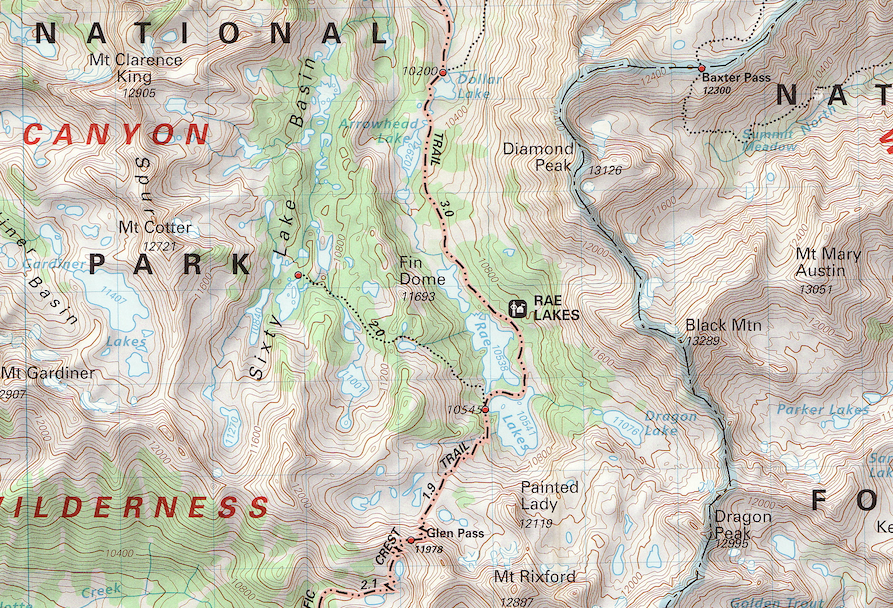
What is a Topo Map?
A topographic map depicts the shapes and orientations of mountains, rivers, lakes, meadows, and other landmark features. The United States Geological Survey (USGS) has been making topographic maps since 1879. While the surveying techniques and accuracy have improved vastly since then, the ever-changing world leaves the USGS scrambling to update their maps. The most detailed version of the topo map released by the USGS is the 7.5 minute quadrangle (called quad or topo quad for short), which depicts features at a scale of 1 to 24,000 (one map unit = 24k real world, or 1 inch equals 24,000 inches or 2,000 feet) and covers 7.5 minutes of geographic latitude and 7.5 minutes of geographic longitude. Each USGS topo quad has a unique name, usually of the prominent peak, town or other feature in the map.
Reading Topo Maps
It takes a lot of practice to get good at reading topo maps. A scene from The Matrix comes to mind – Cypher says to Neo “You get used to it. I don’t even see the code. All I see is blonde, brunette, redhead.” I can assure you – the same is true for reading topo maps; eventually you won’t see lines of elevation. Rather, you will just see ridges and canyons and you’ll be able to hopefully match those features to the terrain that surrounds you.
The first thing I ‘read’ from a topo map is where lines make a V or U shape. This is either a stream/canyon or a ridge. I also look for concentric rings which are either peaks or depressions. (Depressions are pretty rare; they usually form a lake.) From there, the rest of the features start to jump off the page. If you need help, try looking at a topo map with detailed hill shading, like the Terrain feature of Google Maps. When the terrain is shaded intuitively, the contour lines make more sense, and eventually the shading is not required and simply a nice bonus.
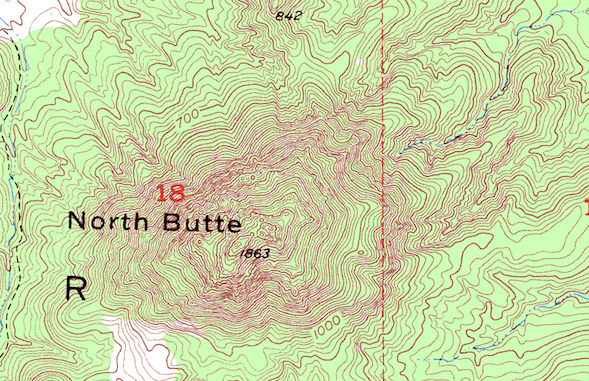
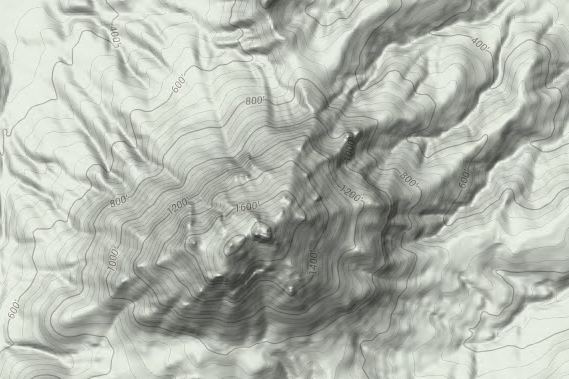
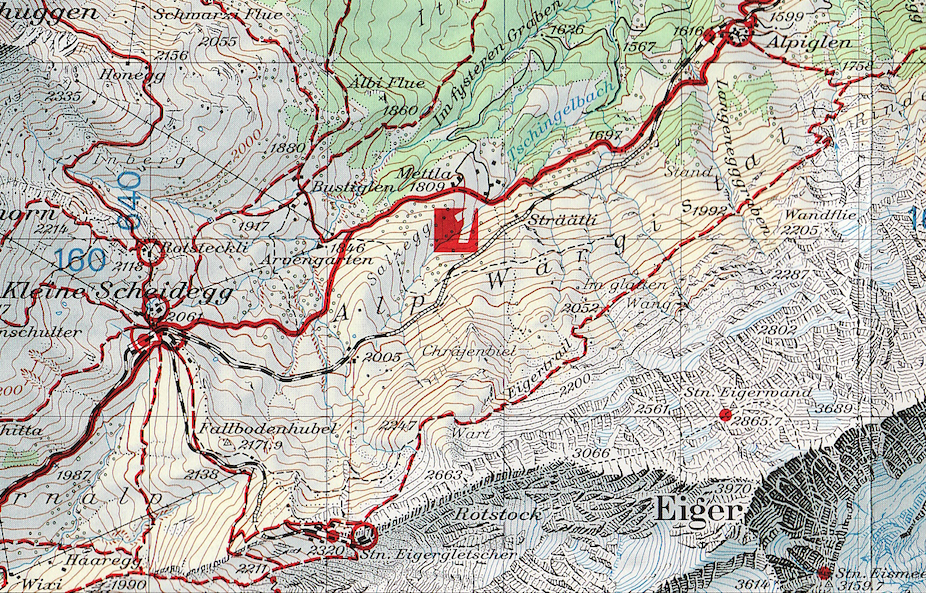
Finding the Quad Sheet
Many hiking books will list one or more topo quad names for the area that the hike covers. There are several ways you can download the topo map that you’re looking for. The easiest way is to go directly to the source – USGS topoView. Or if you already know the name you can search the USGS Historical Map Collection. If you need to print out a few maps without borders, or you want to use the maps in GIS software, you can get them for California from the Cal Atlas, where they are in folders based on whole degrees of Latitude and Longitude. If none of those methods suit you, you can download this nifty kml file, which will show the names of the quad sheets in Google Earth, and will load them on demand when you click them. (This kml is shown in the moving image below.) Viewing topo maps in 3D in Google Earth is another great way to gain an intuition for reading them. When I hike, I usually have both a printout map as well as the USGS maps on this amazing iPhone app: Topo Maps. I advise bringing some kind of printed map for any significant excursion into the wilderness – it is one of the Ten Essentials.
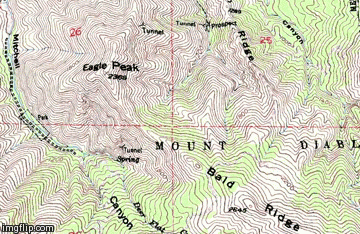
Other Maps for Planning Trips
So you want to plan a trip. Maybe Tom Harrison doesn’t make a paper map that you can use. Maybe the USGS Topo, and Google Maps Terrain both don’t have enough trail information. How will you plan your trip?
To explore a new area, I like to see what the OpenStreetMap data has to offer, and I do so using a great website: GPSies.com. At this fabulous website you can create tracks. The Open Cycle Map is selectable as a base map and it contains contours, hillshade, and most trails. Using the ‘follow trails’ feature (or not if you prefer to travel off trail), you can create a path. The amazing free service will show you the mileage and elevation gain/loss stats, as well as an elevation profile.
So get out there and explore. Bring a map with you and know how to use it.
Update (8/30/2014):
Since posting this, I discovered CalTopo, which has been immensely useful for mapping my hikes. You can make your own high quality printouts at the site, but what if you want to bring the map on your phone, for free? At this time CalTopo does not generate a GeoPDF, which is a pdf that contains meta information about how the coordinates are laid out on the page. However, there’s a great FREE app for Android and iOS called PDF Maps. Now, on your phone, you can download excellent GeoPDF maps from FSTopo or USGS Store, and open them on your phone directly into the PDF Maps app. This means you can view an up-to-date topo map from FSTopo on your phone, see where you are on it, and even mark waypoints, take measurements, or use the compass on the device.

It came as no big surprise to me that many hikers simply don’t have the mental capacity to read any map, when I started with the old hiking club. They constantly got lost, and even unto death, due to this inability. Sorry to say, they simply would have no comprehension of what you are taking about here, and never will! Many people aren’t capable of even arithmetic, let alone any more complicated mathematics, and you might be surprised how high that goes. No end to urban professionals who can’t find their way on trails or backcountry, or even by highways! Most of the old hiking club doesn’t go hiking. They get lost even trying to get to the trailhead!
The PDF Maps app is available for both Iphone and Android (https://www.pdf-maps.com/)
You can download USGS maps from within the app for free. It is very easy to use offline maps and your phone in airplane mode with just the GPS enabled to determine your location on the maps. I wish I had this resource when I did the JMT in 2010.
USGS 7.5K Quads included in JMT (from North to South)
Half Dome
Merced Peak
Tenaya Lake
Vogelsang Peak
Kolp Peak
Mount Ritter
Mammoth Mountain
Crystal Crag
Bloody Mountain
Graveyard Peak
Florence Lake
Mount Hilgard
Mount Henry
Mount Darwin
Mount Goddard
North Palisade
Split Mountain
Mount Pinchot
Mount Clarence King
Kearsarge Peak
Mount Brewer
Mount Williamson
Mount Kaweah
Mount Whitney
Mount Langley
Oh, that’s funny we did the JMT in the same year! I like PDF Maps a lot – it has become my go-to app. If I did the JMT now I would probably just make my own tile package of the trail over at CalTopo and copy those URLs into the PDF Maps app. The USFS topo is generally a lot nicer than the USGS, especially for that area. The Mt Williamson USGS map for instance is in meters (crazy), but the USFS one is newer and in feet. And now it’s made better since iOS 8.3 the iPhones can use GPS in airplane mode.
Thanks for the summary!